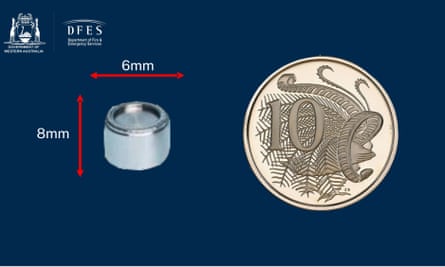Authorities are continuing the search for a tiny radioactive capsule lost along a 1,400km stretch of Western Australian desert highway.
The 8mm by 6mm capsule fell from a secure device on a truck that was travelling from a Rio Tinto mine site, north of Newman in the Pilbara region, to Perth, where it was being sent for repair.
According to WA authorities, the capsule was packaged on 10 January, transported offsite on 12 January, and the casing it was contained within arrived in Perth on 16 January. It wasn’t until nine days later, on 25 January, that it was discovered missing when the package was unpacked for inspection.
WA’s Department of Fire and Emergency Services on Monday said radiation specialists were searching along the Great Northern Highway by “driving north and south directions at slow speeds”. The department said earlier it was using radiation detection equipment that could be fitted to vehicles in the search.
What is the capsule used for?
The missing capsule is a 19-GBq (gigabecquerel, a unit of radioactive decay) caesium-137 ceramic source, commonly used in radiation gauges. Caesium-137 is a radioactive metal with a half-life of 30.05 years – meaning in three decades it will have half of its original activity. It emits beta and gamma radiation.
In the missing capsule, the caesium is bound in a “ceramic matrix” rather than existing in a loose powder form. The caesium-137 is encapsulated by steel, which prevents beta particles from penetrating through.
Sign up for Guardian Australia’s free morning and afternoon email newsletters for your daily news roundup
The general manager of Radiation Services WA, Lauren Steen, said capsules like these are commonly used industrially as fixed radiation gauges, which measure the density and flow of materials. They are widely used in the mining, and oil and gas industries.
“What they look at is the rate of flow or level in a pipe,” Steen said. The gamma rays emitted by the caesium-137 penetrate through the pipe and are picked up on the other side by a detector.
Steen said a radioactive source like the missing capsule was typically designed to be left in place for a lifespan of about 15 years, with yearly regulatory checks.

The source would continue to be radioactive and detectable above natural background radiation levels in the environment for about 300 years, according to Dale Bailey, a professor of medical imaging science at the University of Sydney.
In the medical setting, caesium-137 has historically been used in radiotherapy. “One of the biggest sources in a hospital is the blood irradiator – you sterilise blood with the gamma photons from cobalt-60 or caesium before you do a transfusion,” Bailey said.
How dangerous is the capsule?
Bailey said the missing capsule posed two main hazards to humans: exposure, and the more serious concern, contamination, which occurs when radioactive material comes into contact with something, such as the human body or soil or a road.
“Exposure is like sitting in the sun on a hot day and getting UV radiation,” he said. “If you limit your time and you maximise your distance from it, then you limit how much exposure you get.”
Authorities have said spending an hour at one metre’s distance from the missing capsule was similar to receiving 10 X-rays, but Radiation Services WA estimates the radiation dose is about 17 chest X-rays.
It estimates the capsule’s radiation dose is about 1.665 millisieverts an hour. The normal amount of background radiation a person in Australia is exposed to in a year is about 1.5 millisieverts.
The capsule’s steel container prevents radioactive material escaping, but if it were to be broken, contamination would be a greater worry.
The beta particles – no longer contained by a barrier – could cause serious damage, resulting in reddening of the skin, or ulceration or tissue death in severe cases, Bailey said.
after newsletter promotion
“When you get contaminated, it’s in your body,” he said. Ingestion would be very dangerous. Caesium “would go to the bone, because that’s just what caesium does … then you’re going to have continuous radiation by the beta particles and the gamma rays. They’re not going to be eliminated.”
“If you swallow this source, you’re likely to get local ulceration in the gut and that can lead to a rupture.”
How many similar capsules exist?
According to Radiation Services WA, there are thousands of radioactive sources around the state that are used and transported daily without issue.
“The Radiological Council of WA or any radiation health unit in any state or territory in Australia, or around the world, knows each and every single source – they have a database,” Steen said. “They would have to go through a federal import process as well.”
Transport of sources between locations often requires prior submission of regulatory documents.
“Checks and balances are in place, but it’s probably a bit of a wake up call to all the companies about the serious nature of radioactivity,” Steen said.
Caesium-137 capsules are commonly imported, although Bailey said local manufacture would be possible at the Australian Nuclear Science and Technology Organisation’s (Ansto) nuclear reactor. “It’s a byproduct of the uranium fission reaction,” he said.
Steen said: “I’m not aware of anybody who manufactures them in Australia.”
The WA Radiological Council was contacted for comment.
What happens to nuclear waste?
Once they are no longer useful, capsules like the missing source are typically exported if they have been manufactured elsewhere. “Generally speaking, you’re unable to dispose of anything not generated in WA within WA,” Steen said. “Anything that comes from overseas generally goes straight back.”
Bailey agreed: “Traditionally in Australia, we’ve sent it back to its source, maybe the US or Canada or Europe.”
Most of the nuclear waste Australia does have is stored at Ansto’s facilities at Lucas Heights.
In 2020 the Morrison government selected a site near Kimba, South Australia, for a national nuclear waste facility but the decision has faced a legal challenge from Barngarla traditional owners.